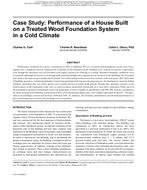Description
Performance attributes of a house, constructed in 2001 in Madison, WI, on a treated-wood foundation system were investigated over a multiyear period. Temperature conditions in the basement of the building were, without exception, comfortable, even though the basement was not provided with supply registers for heating or cooling. Basement humidity conditions were acceptable (although not ideal), even though dedicated dehumidification equipment was not used in the building. The basement zone did not develop any perceptible smell of mold. No visible mold growth occurred on surfaces in the basement. After 98 months of building operation, with design humidity levels being maintained during most heating seasons, the foundation system (including cellulose insulation that was below grade) was virtually devoid of visible mold growth. Despite this, moisture contents in the bottom plates of the foundation walls were, at most locations monitored, chronically at or near fiber saturation. Other parts of the foundation remained substantially drier, but apparently at levels roughly in equilibrium with 80% RH. Energy consumption for space heating of the building, normalized to floor area and heating degree days, was roughly equivalent to that for “average” American dwellings constructed between 1990 and 2001. In summary, the moisture performance and thermal performance of the wood foundation system of this building were acceptable.
Citation: Thermal Performance, International Conference, 2010
Product Details
- Published:
- 2010
- Number of Pages:
- 17
- File Size:
- 1 file , 420 KB
- Product Code(s):
- D-BUILDINGSXI-119




